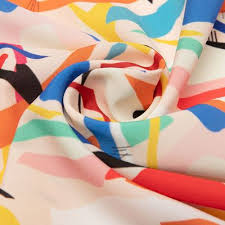Unlike screen printing, which requires multiple screens for each color, digital printing is versatile and allows unlimited design variations without added setup costs. This makes it ideal for customized, small-batch, or mass production projects.
The textile and fashion industries are evolving rapidly, and custom digital printing on fabric is at the forefront of this transformation. Unlike traditional printing methods that rely on screens, stencils, or rollers, digital printing directly applies designs onto fabrics using advanced inkjet technology. This modern method allows designers, businesses, and individuals to create unique, vibrant, and highly detailed fabric designs without the limitations of conventional printing techniques.
From high-fashion apparel and sportswear to personalized home décor and promotional products, digital printing has opened new doors of creativity and efficiency. This article explores everything you need to know about custom digital fabric printing—its process, benefits, applications, and future potential.
What is Custom Digital Printing on Fabric?
Custom digital printing on fabric is a non-contact printing technique that transfers designs directly from a digital file to textiles. Using specialized printers and eco-friendly inks, it creates sharp, full-color prints with photographic precision.
Unlike screen printing, which requires multiple screens for each color, digital printing is versatile and allows unlimited design variations without added setup costs. This makes it ideal for customized, small-batch, or mass production projects.
How the Digital Printing Process Works
- Design Preparation – The artwork is created in graphic design software and prepared in a digital format.
- Fabric Pre-Treatment – The chosen fabric is pre-coated to enhance ink absorption and ensure long-lasting results.
- Printing – The digital printer sprays ink directly onto the textile with high precision.
- Fixation – Heat or steam treatment is applied to set the ink permanently.
- Finishing – The fabric undergoes washing and finishing to achieve durability, softness, and colorfastness.
This streamlined process makes digital fabric printing faster, cleaner, and more adaptable compared to conventional methods.
Key Advantages of Custom Digital Fabric Printing
Unlimited Design Freedom
Digital printing allows the reproduction of complex patterns, gradients, and photographic images that are nearly impossible with traditional printing.
Cost-Effective for Small and Large Runs
Unlike screen printing, digital printing has no setup costs for screens or plates, making it economical for small orders and scalable for large production runs.
Eco-Friendly Production
Digital printing consumes less water, generates minimal waste, and uses eco-friendly inks—supporting sustainable practices in the textile industry.
Speed and Efficiency
Designs can be printed instantly, reducing turnaround times and enabling quick product launches for fashion brands and businesses.
High-Quality Prints
Digital prints deliver sharp details, vibrant colors, smooth gradients, and excellent wash durability, ensuring premium-quality fabrics.
Popular Applications of Custom Digital Fabric Printing
- Fashion and Apparel – Dresses, scarves, shirts, sportswear, and luxury fashion items.
- Home Textiles – Custom curtains, cushions, upholstery, and bed linens.
- Promotional Products – Branded merchandise like tote bags, uniforms, and banners.
- Interior Design – Wall hangings, decorative panels, and personalized furniture fabrics.
- DIY & Small Businesses – Personalized gifts, craft projects, and niche fashion lines.
This versatility makes digital printing a go-to solution for industries that value customization and creativity.
Types of Fabrics Best for Digital Printing
Not every fabric reacts the same way to digital printing. Some of the most commonly used fabrics include:
- Cotton – Breathable, versatile, and ideal for apparel and home textiles.
- Silk – Luxurious feel and excellent for scarves, dresses, and high-end fashion.
- Polyester – Durable and suitable for sportswear, banners, and upholstery.
- Linen – Natural and stylish, perfect for interior applications.
- Fabric Blends – Cotton-poly blends offer both durability and print vibrancy.
Proper pre-treatment is essential for achieving optimal print results on these fabrics.
The Role of Technology in Digital Fabric Printing
Advancements in textile printing technology have made digital printing faster, more precise, and more sustainable. Modern printers use:
- High-speed inkjet printheads for efficiency.
- Eco-solvent and pigment inks for durability.
- RIP software (Raster Image Processing) to manage design colors and resolutions.
- 3D preview tools to help designers visualize patterns before printing.
These innovations make custom fabric printing a reliable and future-ready solution.
Future of Custom Digital Printing on Fabric
The textile printing industry is moving rapidly towards digitalization. Emerging trends include:
- On-demand printing for e-commerce and small businesses.
- Sustainable technologies with waterless printing systems.
- Integration with smart textiles, enabling interactive fabrics.
- Faster production speeds with industrial-grade digital printers.
As consumer demand shifts toward personalization and eco-conscious fashion, digital printing will continue to dominate the textile sector.
FAQs
How is digital printing different from screen printing?
Screen printing requires stencils and is best for simple, large orders with limited colors. Digital printing allows unlimited colors, detailed designs, and is cost-effective for both small and bulk production.
Is custom digital printing durable?
Yes. When fabrics are properly pre-treated and finished, digital prints are long-lasting, resistant to fading, and remain vibrant after multiple washes.
Can any fabric be digitally printed?
No. While cotton, polyester, silk, and blends are commonly used, not all fabrics absorb ink equally. Pre-treatment is essential for high-quality results.
Is digital printing eco-friendly?
Yes. It uses less water, reduces chemical waste, and employs sustainable inks, making it more environmentally friendly than traditional methods.
How much does digital fabric printing cost?
Pricing depends on the type of fabric, design complexity, and order size. However, for small runs and custom projects, it is generally more cost-efficient than screen printing.
Conclusion
Custom digital printing on fabric is more than a trend—it is a revolution in the textile world. Offering unmatched design freedom, superior quality, and sustainable production, it empowers designers, businesses, and individuals to bring their ideas to life. From fashion apparel to home décor, its applications are limitless and its benefits undeniable.
As technology continues to advance, the future of textile printing lies in digital innovation and customization. For businesses and creatives looking to stay competitive in today’s fast-paced market, adopting custom digital printing on fabric is not just an option—it’s a necessity.


